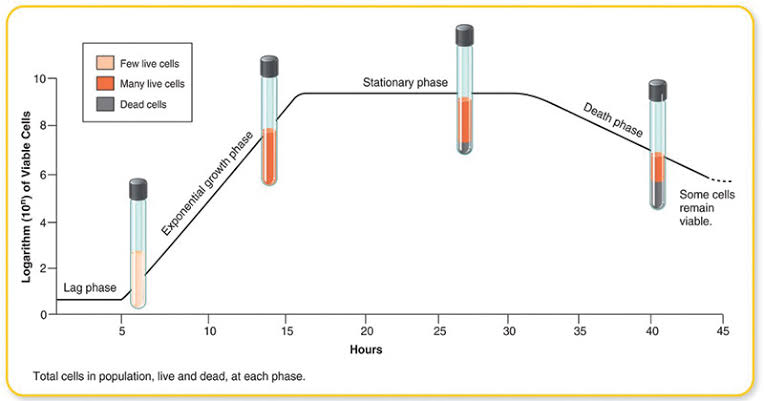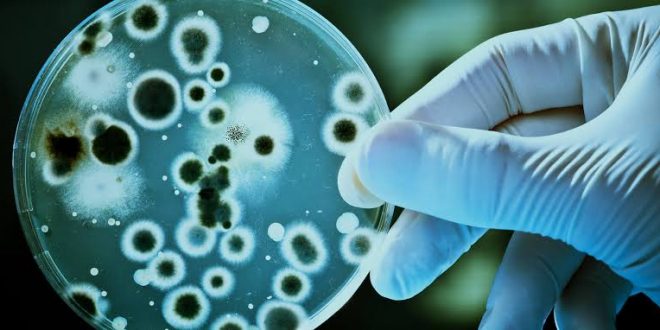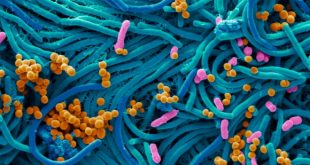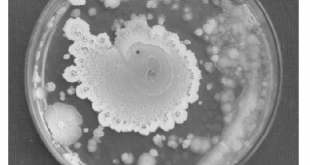Generation Time
The time required for a cell to divide or a population to divide is known as the generation time. For bacteria it is the time, required for a complete fission cycle. Generation time depends on nutrient media, pH, temperature etc.
The generation time “g” can be determined from the number of generations “n” that occur in a particular time interval “t”.
g=t/nG
Growth rate
The rate of bacterial multiplication per hour is called the growth rate (R). Growth rate depends on generation time “g”. It is the alternative value of generation time.
Growth rate, R=1/g= t/n
Bacterial growth curve
When a few bacteria are inoculated into a liquid growth medium and population is counted at intervals, it is possible to plot a bacterial growth curve showing growth of cells over time. It is difficult to show changes in population by using arithmetic numbers. For showing the growth curve logarithmic scales are generally used.
There are 4 basic phases of growth
Best safe and secure cloud storage with password protection
Get Envato Elements, Prime Video, Hotstar and Netflix For Free
Best Money Earning Website 100$ Day
#1 Top ranking article submission website
- Lag phase,
- Log phase/ exponential phase,
- Stationary phase,
- Death phase
1. Lag phase: In a fresh medium after few cells are inoculated, for a while number of cells changes very little because the cells do not immediately reproduce. Some cells may die from the shock of transfer or the inability to adapt to the new environment. This period of little or no cell division is called the lag phase. It can last for 1 hour or several days. During this time, however, the cells are not dormant. The microbial population is undergoing a period of intense metabolic activity involving in particular, synthesis of enzymes and various molecules. Physiologically they are very active and are synthesizing new protoplasm.
2. Log phase: Eventually, the cells begin to divide and enter a period of growth or logarithmic increase, called the log/ exponential growth phase. It is a period during which the curve increases geometrically. Cellular reproduction is most active during this period and generation time reaches a constant minimum. Because the generation time is constant, a logarithmic plot of growth during log phase is a straight line. This phase will continue as long as cells have adequate nutrients and the environment is favorable. During this phase, the population fulfills its potential generation time and growth is balanced and genetically coordinated. The log phase is the time when cells are most active metabolically and is preferred for industrial purposes.
3. Stationary phase: The number of microbial death balances the number of new cells and population stabilizes. This period of equilibrium is called stationary phase. In this phase, the population enters a survival mode in which cells stop growing or grow slowly. The curve levels off because the rate of cell death balances out the rate of multiplication. What causes exponential growth to stop is not always clear. The exhaustion of nutrients, accumulation of waste products and harmful changes in pH may all play a role.
4. Death phase: As the limiting factors intensity, cells begin to die at exponential rate (literally perishing in their own wastes) and most are unable to multiply. The number of deaths eventually exceeds the number of new cells formed and the population enters the death phase/ logarithmic decline phase. This phase continues until the population is diminished to tiny fraction of the number of cells in the previous phase or until the population dies out entirely. The speed with which death occurs depends on the relative resistance of the species and how toxic the conditions are, but it is usually slower than the exponential growth phase. Viable cells often remain many weeks and months after this phase has begun. In the laboratory, refrigeration is used to slow propagation of death phase so that cultures remain viable as long as possible. For some bacterial species, especially soil bacteria, they can escape cell death by forming endospores.

Mathematical expression of microbial growth
Bacteria normally reproduce by transverse binary fission. As cells divide, the population increases exponentially. Numerically, this follows,-
20_ 21_ 22 _ 23_ 24_…………………….2n
Here, n= number of generations.
Total population, N= 1× 2n…….(1)
But during inoculation bacterial number is 1, if the initial number of cell is N0
N= N× 2n…….. (2)
Using log on both side of equation 2
log10 N = log10 N0 × log10 2n
or, log10 N = log10 N0 × n log10 2
or, n log10 2 = log10 N – log10 N0
or, n= (log10 N – log10 N0)/ 0.301
(As, log10 2= 0.301)
The generation time “g” can be determined from the number of generations “n” that occur in a particular time interval “t”,
g=t/n
The growth rate R is reciprocal value of generation time “g”,
R= 1/g= n/t
Effects of the temperature on bacterial growth
Most microorganisms grow well at the temperature that human favor. Microbial cells can not control their temperature and therefore assume the ambient temperature of their natural habitats. To survive, they must adapt to whatever temperature variations are encountered in their habitat. Most bacteria grow only within a limited range of temperature and their maximum and minimum growth temperatures are only about 30°C apart. However, certain bacteria are capable of growing at extremes of temperature that would certainly hinder the survival of almost all eukaryotic organisms.
The range of temperature for microbial growth can be expressed as three cardinal temperature. Each bacterial species grow at particular minimum, optimum and maximum temperatures. The minimum growth temperature is the lowest temperature at which the species will grow. Below this temperature, its activities are inhibited. The optimum growth temperature is the temperature at which species grows best. It covers a small range, intermediate between the minimum and maximum, which promotes the fastest growth and metabolism. Only rarely is the optimum a single point. The maximum growth temperature is the highest temperature at which growth is possible. If the temperature rises slightly above maximum, growth will stop. If it continues to rise beyond the point, the enzymes and nucleic acids will eventually become permanently inactivated; a condition known as denaturation and the cell will die.
Microorganism are classified into three primary groups on the basis of their preferred range of temperature:
- Psychrophiles (cold-loving microbes)
- Mesophiles (moderate-temperature loving microbes) and
- Thermophiles (heat-loving microbes)
Psychrophiles
Organisms capable of growing at 0°C . There are two fairly distinct groups.
One group composed of organisms that have a optimum growth temperature of 15°C. These microorganisms are sensitive that they will not even grow at room temperature (25°C). Found mostly in the ocean depths or in certain polar region.
Other group composed of organism that have optimum temperature of 20-30°C and can not grow above 40°C. These may be called psychro-tolerant. e.g. Staphylococcus aureus.
Mesophiles
Organisms having an optimum growth temperature of 25-40°C. These are the most common type of microbes. Mesophiles include most of the of spoilage and disease organisms.
Thermophiles
Thermophiles are microorganisms capable of growth at high temperature. Many of these organisms have an optimum growth temperature of 50-60°C. Such temperatures can also be reached in sunlit soil and thermal waters such as hot springs. Remarkably, many thermophiles can not grow at temperatures below about 45°C. Endospores formed by thermophilic bacteria are very heat resistant. However, thermophiles pose little threat to human health because they don’t grow well at cooler temperature of the body. Thermophiles are important in organic composts files, in which the temperature can rise rapidly to 50-60°C. Currently, there is intense interest in thermal microorganisms on the part of biotechnology companies.
One of the most profitable discoveries so far was a strict thermophile Thermus aquaticus, which produces an enzyme that can make copies of DNA at high temperatures. These enzymes “Taq polymerase” is now an essential component of the PCR. Some microbes, members of the Archaea, have an optimum growth temperature of 80°C or higher. These organisms are called hyperthermophiles or sometimes extreme thermophiles. Most of these organisms live in hot springs associated with volcanic activity; Sulfur is usually important in their metabolic activity. The known record for bacterial growth and replication at high temperatures is about 121°C near deep-sea hydrothermal vents. The immense pressure in the ocean depths prevents water from boiling even at temperatures well above 100°C.
Effects of pH
Most bacteria grow best in a narrow pH range near neutrality, between pH 6.5 and 7.5; these are called Neutrophiles. However, some bacterial species, such as Vibrio cholerae, can tolerate acidic conditions as low as pH 2.0 and alkaline conditions as high as pH 9.5. Very few bacteria grow at an acidic pH below about pH 4.0. This is why a number of foods, such as sauerkraut, pickles and many cheeses are preserved from spoilage by acids produced by bacterial fermentation.
Acidophiles
Some bacteria are remarkably tolerant of acidity called acidophiles. One type of chemoautotrophic bacteria. e.g. Thermoplasma can survive at a pH value of 1. The optimum pH of molds and yeast is 5-6. The most acidophilic prokaryote is Picrophilus oshimae, growing optimally at pH 0.7 and 60°C.
Alkaliphiles
Microorganisms showing growth at pH of 8 or higher are called alkaliphiles.
Bacillus firmus is alkaliphilic but has an unusual broad pH range for growth from 7.5 to 11.
 Plantlet The Blogging Platform of Department of Botany, University of Dhaka
Plantlet The Blogging Platform of Department of Botany, University of Dhaka





